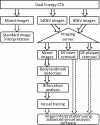Evaluation of computer-assisted quantification of carotid artery stenosis
- PMID: 21786073
- PMCID: PMC3295974
- DOI: 10.1007/s10278-011-9413-y
Evaluation of computer-assisted quantification of carotid artery stenosis
Abstract
The purpose of this study was to evaluate the influence of advanced software assistance on the assessment of carotid artery stenosis; particularly, the inter-observer variability of readers with different level of experience is to be investigated. Forty patients with suspected carotid artery stenosis received head and neck dual-energy CT angiography as part of their pre-interventional workup. Four blinded readers with different levels of experience performed standard imaging interpretation. At least 1 day later, they performed quantification using an advanced vessel analysis software including automatic dual-energy bone and hard plaque removal, automatic and semiautomatic vessel segmentation, as well as creation of curved planar reformation. Results were evaluated for the reproducibility of stenosis quantification of different readers by calculating the kappa and correlation values. Consensus reading of the two most experienced readers was used as the standard of reference. For standard imaging interpretation, experienced readers reached very good (k = 0.85) and good (k = 0.78) inter-observer variability. Inexperienced readers achieved moderate (k = 0.6) and fair (k = 0.24) results. Sensitivity values 80%, 91%, 83%, 77% and specificity values 100%, 84%, 82%, 53% were achieved for significant area stenosis >70%. For grading using advanced vessel analysis software, all readers achieved good inter-observer variability (k = 0.77, 0.72, 0.71, and 0.77). Specificity values of 97%, 95%, 95%, 93% and sensitivity values of 84%, 78%, 86%, 92% were achieved. In conclusion, when supported by advanced vessel analysis software, experienced readers are able to achieve good reproducibility. Even inexperienced readers are able to achieve good results in the assessment of carotid artery stenosis when using advanced vessel analysis software.
Figures




Similar articles
-
Carotid artery stenosis: performance of advanced vessel analysis software in evaluating CTA.Eur J Radiol. 2012 Sep;81(9):2255-9. doi: 10.1016/j.ejrad.2011.08.011. Epub 2011 Sep 17. Eur J Radiol. 2012. PMID: 21930358
-
Carotid artery stenosis quantification: concordance analysis between radiologist and semi-automatic computer software by using Multi-Detector-Row CT angiography.Eur J Radiol. 2011 Jul;79(1):80-4. doi: 10.1016/j.ejrad.2009.11.025. Epub 2009 Dec 23. Eur J Radiol. 2011. PMID: 20031358
-
Automatic bone and plaque removal using dual energy CT for head and neck angiography: feasibility and initial performance evaluation.Eur J Radiol. 2010 Oct;76(1):61-7. doi: 10.1016/j.ejrad.2009.05.004. Epub 2009 Jun 10. Eur J Radiol. 2010. PMID: 19520534
-
Semi-automatic level-set based segmentation and stenosis quantification of the internal carotid artery in 3D CTA data sets.Med Image Anal. 2007 Feb;11(1):21-34. doi: 10.1016/j.media.2006.09.004. Epub 2006 Nov 27. Med Image Anal. 2007. PMID: 17126064
-
Carotid vessel evaluation via a 3-D workstation.Radiol Technol. 2013 Sep-Oct;85(1):107-11. Radiol Technol. 2013. PMID: 24029893 Review. No abstract available.
Cited by
-
Overcoming calcium blooming and improving the quantification accuracy of percent area luminal stenosis by material decomposition of multi-energy computed tomography datasets.J Med Imaging (Bellingham). 2020 Sep;7(5):053501. doi: 10.1117/1.JMI.7.5.053501. Epub 2020 Oct 1. J Med Imaging (Bellingham). 2020. PMID: 33033732 Free PMC article.
-
CT Angiography Manual Multiplanar Vessel Diameter Measurement vs. Semiautomated Perpendicular Area Minimal Caliber Computation of Internal Carotid Artery Stenosis.Front Cardiovasc Med. 2021 Dec 9;8:740237. doi: 10.3389/fcvm.2021.740237. eCollection 2021. Front Cardiovasc Med. 2021. PMID: 34957236 Free PMC article.
-
Coronary artery center-line extraction using second order local features.Comput Math Methods Med. 2012;2012:940981. doi: 10.1155/2012/940981. Epub 2012 Nov 22. Comput Math Methods Med. 2012. PMID: 23227111 Free PMC article.
-
Systematic review of preoperative carotid duplex ultrasound compared with computed tomography carotid angiography for carotid endarterectomy.Ann R Coll Surg Engl. 2019 Mar;101(3):141-149. doi: 10.1308/rcsann.2019.0010. Epub 2019 Feb 15. Ann R Coll Surg Engl. 2019. PMID: 30767557 Free PMC article.
-
Diagnostic Accuracy of 4 Commercially Available Semiautomatic Packages for Carotid Artery Stenosis Measurement on CTA.AJNR Am J Neuroradiol. 2015 Oct;36(10):1978-87. doi: 10.3174/ajnr.A4400. Epub 2015 Aug 6. AJNR Am J Neuroradiol. 2015. PMID: 26251425 Free PMC article.
References
-
- Hollingworth W, Nathens AB, Kanne JP, Crandall ML, Crummy TA, Hallam DK, Wang MC, Jarvik JG. The diagnostic accuracy of computed tomography angiography for traumatic or atherosclerotic lesions of the carotid and vertebral arteries: a systematic review. Eur J Radiol. 2003;48:88–102. doi: 10.1016/S0720-048X(03)00200-6. - DOI - PubMed
-
- Josephson SA, Bryant SO, Mak HK, Johnston SC, Dillon WP, Smith WS. Evaluation of carotid stenosis using ct angiography in the initial evaluation of stroke and TIA. Neurology. 2004;63:457–460. - PubMed
-
- Koelemay MJW, Nederkoorn PJ, Reitsma JB, Majoie CB. Systematic review of computed tomographic angiography for assessment of carotid artery disease. Stroke. 2004;35:2306–2312. doi: 10.1161/01.STR.0000141426.63959.cc. - DOI - PubMed
MeSH terms
Substances
LinkOut - more resources
Full Text Sources
Other Literature Sources
Medical

